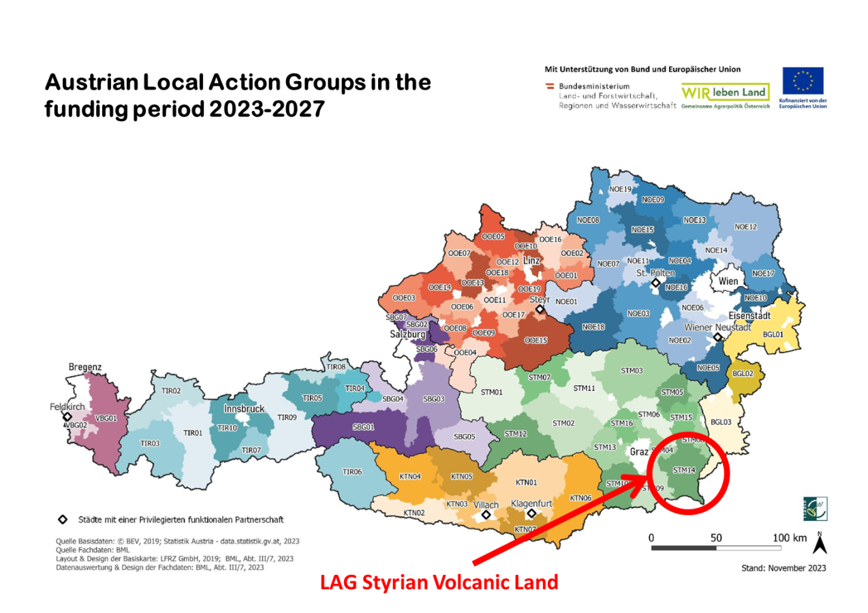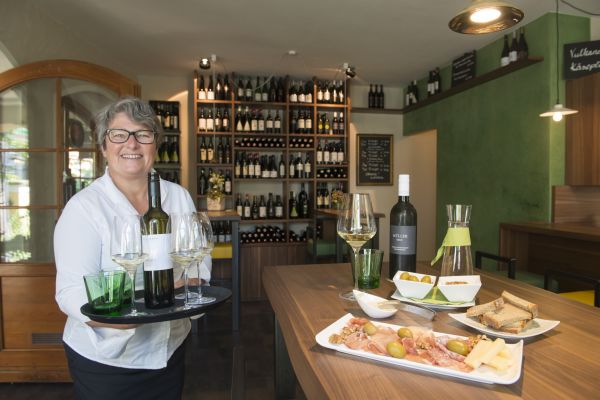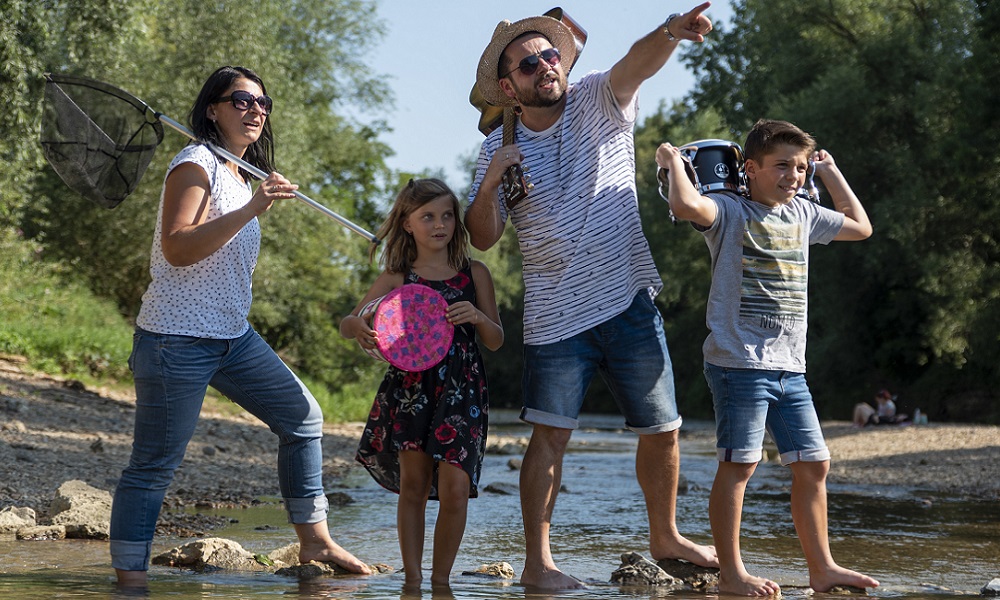The Austrian LAG Styrian Volcanic Land (Steirisches Vulkanland) wanted to know what its local development efforts stretching over a quarter of a century have been ultimately good for. This groundbreaking impact study was entrusted to an ÖAR team assisted by students from the Vienna University [1]
Robert Lukesch
The study aimed to evaluate the intended and unintended effects of the development incentives of the Local Action Group and the LAG management in the LEADER area “Steirisches Vulkanland” since 1999 in a participative process. Its findings are intended to help improve regional governance, facilitate the selection of future interventions and eventually strengthen the functioning of democratic institutions in the spirit of subsidiarity, civic engagement and ownership.

Fig.1: The LAG Styrian Volcanic Land, bordering to Slovenia in the South. The area used to be, until the fall of the Iron Curtain in 1989, one of the most disadvantaged rural areas in Austria.
The area of 1.123 km2 and approximately 100.000 inhabitants, composed of 30 municipalities, straddles three political districts of the State of Styria (Steiermark), whereas 25 of them cover one entire district named South East Styria (Südoststeiermark). Subsequently, the “Regionalmanagement Südoststeiermark”, a State-law governed development agency based on the 25 municipalities of the district, cherishes close organisational ties with the LAG management in terms of both strategic approach and personal involvement. The LAG has grown into its present shape in several steps, having started with a precursor during LEADER II (1995-1999) which operated in only four municipalities, comprising the main district town (Feldbach) and three neighboring municipalities of South East Styria. This precursor left a determining imprint because the pioneering actors from those times (local politicians, committed individuals from the public and private sector and researchers from the Technical University of Graz) did not only coin the name “Volcanic Land” but also the philosophy of intervention which emphasized values derived from endogenous and sustainable development approaches. The key actors remained in place until nowadays, apart from some changes due to generational renewal. From 2000 to 2024, two LAG managers have been in office, both of whom subsequently moved from the LAG to the above mentioned “Regionalmanagement” and were replaced by people from the LAG staff. The current chairman is the very person having co-founded and chaired the previously mentioned precursor LAG.
The crucial question behind the study has been: How can the impacts from interventions over such a long period of time be measured? This endeavor obviously reaches far beyond the evaluation of a set of measures, projects or a program funded within a certain period. The team decided for a top-down approach, namely to search for significant changes in the region using statistical data (92 area-based indicators) and subjective perceptions of 114 people who actively participated in 42 individual interviews, three thematic focus groups (on culinary arts, crafts and ecological sustainability) and five sub-regional citizen panels. Furthermore the team compared the trajectory of indicator values with those of three other LEADER areas which, by the year 2000, had shown the most similar features according to some geographical and socio-economic key indicators (two of the contrast areas were in fact neighboring LAGs). These data allowed us to identify as “significant changes” those indicator values which were distinctly different from those of the contrast areas. Through the hermeneutic process during the qualitative analysis we could finally attribute these distinctive phenomena to net effects of the development incentives of the LAG Steirisches Vulkanland. In other words, the exploration essentially consisted of gradually eliminating alternative explanations for the causes of the observed changes, until it became evident that the LAG interventions had to be at least one of their main drivers.
From the very beginning, the LAG pursued two strategic focus areas, the culinary arts and the craft sector, embedded in overarching sustainability goals: 100% energy self-sufficiency and half of the local consumption (in monetary terms) being produced in the region (50% regional value added). In order to pursue its strategic goals, the LAG invested about half of the budget (approx. EUR 500,000 annually) into projects managed by the LAG itself. In the very beginning it bet on flagship projects; however, these did not yield the desired results in terms of mobilizing local actors. Therefore, under LEADER+ (2000-2006), it moved on to casting cooperation, education and networking processes into lead projects and managing them centrally, first and foremost in the mentioned thematic focus areas. Key actors in both priority fields have been taken on board during the whole process. They are grouped in a food cluster and a cluster on technology and crafts, supported by the LAG in cooperation with research institutes over the long term.
Apart from the strategic focus areas which the LAG promotes proactively, it also pursues a second method of intervention, in which it acts as a multiplier and accelerator of social innovations, crossing barriers between municipalities and institutions, particularly in areas recognized as culturally and socially relevant (parent-child education, health, lifestyle, local culture and tradition, humus-enriching soil and climate-positive forest management). The LAG is well networked regionally and across the continent, as evidenced by numerous visits by delegations of local action groups from Austria, the EU and beyond.

Fig. 2: Typical landscape feature with some of the 42 extinct volcanos shaping the area with its small settlement and production structures (Source: Bernhard Bergmann/Steirisches Vulkanland).
According to the LAG philosophy, interventions for education and cooperation are at the core of the processes facilitated by the LAG in whatever field of intervention. From the very beginning (1999), the networking and educational work was closely linked to the development and management of the “Vulkanland” brand, which very quickly gained great national recognition.

Fig. 3: The logo of the regional brand which is used by a network of more than 200 enterprises and non-profit associations (Source: www.vulkanland.at).
Since 2004, an innovation prize has been awarded each year to encourage local actors to come forward with new ideas, products and services and to accord them condign recognition. Both, the brand and the innovation prize, have been identified as most important mechanisms for keeping together an ever growing community of entrepreneurs, associations and municipalities which show their commitment to the Vulkanland vision which, since about ten years, is based on the threefold tenet of “human(e), ecological and economic future-ability”.
In the course of the empirical research, the study team came to the conclusion that the founders of the LAG showed a very good sense of the opportunities and challenges for the area, having anticipated macro-political and global economic trends, and transforming them into local advantages. These challenges and trends include the fall of the Iron Curtain (1989), Austria’s accession to the EU (1995) and the EU enlargement (2004), which entailed specific risks and development needs on the region’s small-scale economy and agriculture; however there was also the thriving thermal spa tourism and overall social trends towards wellness and culinary arts, as well as the nationwide expansion of infrastructure and transport links, which enabled the area to catch up with the living standards of urban areas in recent decades.
In short, vision-led communication and successful brand management were key drivers to bring about noticeable changes in attitude among opinion leaders and the population in the Styrian Volcanic Land. The local action group has succeeded in encouraging many people to take new social, technological and economic paths and thus awaken innovative strength, willingness to cooperate and regional cohesion.
As a further consequence, the LAG was able to make a substantial contribution to the development of the “Culinary Area Vulkanland”. The currently existing and ever-growing variety of offers (“transparent factories” and experiential shopping locations) is presented by the fancifully designed “Route 66” guidance system, which opened in 2022.

Fig. 4: “Sissi’s wine bar” in the district town of Feldbach, one of the shops where the culinary richness of the Vulkanland can be experienced (Source: Bernhard Bergmann/Steirisches Vulkanland).
To a certain extent, although substantially furthered by external co-factors (improved train and road transport links, affordable construction and housing costs), this also applies to the enhanced image and qualification of local craft entrepreneurship and thus to stabilizing the craft sector (as can be evidenced in numbers of jobs, company start-ups and apprenticeship) as a “European Crafts Region”.
The operations of the Local Action Group have also contributed to better cooperation between the municipalities and other institutional actors and thus to the success of the reform of regional development and community structures initiated by the State of Styria and implemented between 2009 and 2015.
The positive changes described above, which can be attributed to LAG activities, also feature some differences within the area. The area of origin (the four municipalities having been involved in the precursor-LAG) is likely to have benefited the most ̶ here, too, external co-factors such as regional concentration processes must be taken into account ̶ whilst these effects decrease towards the fringes, especially towards the south where the landscape is dominated by the plain of the Mur river constituting the border to Slovenia. Since 2021 the river area became part of a UNESCO Biosphere Reserve (Mura-Drava-Danube) which stretches eastward to Slovenia, Croatia, Hungary and Serbia.
As with everything, the effectiveness of the Local Action Group has its limits. The region is still suffering from a lack of jobs. The population has stabilized ̶ the reversal of the migration movements of people of family-starting age and of women is particularly encouraging ̶ but the commuter balance has slipped somewhat further into the negative. This has to do with the fact that due to improved traffic links more people have decided to stay at home and to commute on a daily basis – or work remotely – instead of leaving the area and settling elsewhere.
With regard to the goals set for ecological sustainability (energy autarky, enhanced regional self-sufficiency), no clear differences could be identified in comparison to the contrast areas. While certain progress towards energy self-sufficiency is manifested primarily in the form of increased expansion of photovoltaics, the Vulkanland shows a particularly high rate of soil sealing, a consequence of the economic catching up process over the last decades. Global drivers of “unsustainable” investment and consumption patterns are still drowning out the transformation efforts initiated by local actors and fueled with relatively modest funds.
The study authors derive the following recommendations from the findings:
- The vision and principles that determine the activities of the local action group should be retained and continued.
- The LAG should pursue its strategic focus on culinary arts and crafts&technology, whereas it should play an enhanced role as accelerator of social innovation in the intergenerational cohesion and inclusion of migrant communities.
- The overarching visionary goals of energy self-sufficiency (by 2035) and the (undated) 50% of regional added value should be broken down into verifiable and widely communicated intermediary implementation goals based on negotiated commitments and pledges by the relevant institutional and economic actors – in order to make tangible, closely monitored progress over the next few years.
- The symbolic motif of volcanic fire should be twinned with the overarching topic of “Water”. Water is not only directly connected to the volcanic activities of the past (manifest in the form of thermal baths and mineral waters). The two rivers, Mur and Raab, constitute a fundamental lifeline for the region; drinking water from groundwater sources is as delicate elixir of life (drinking water), a medium of climate change (in the form of enhanced occurrences of droughts on one side and floods on the other) and an economic factor (hydropower energy, pond farming). Adopting this topic as a core concern would also make it possible to bring the population, businesses and institutions in the south of the area closer to ongoing development discourse animated by the LAG.
- The high level of personnel, organizational and strategic continuity should be maintained, especially since it has been identified as a significant success factor. When it comes to gradual generational renewal, the core of the LAG network should be broadened in terms of gender, sub-regional and other diversity criteria. Given the considerable size of the area, a stronger representation of the LAG vision at municipal level would be helpful.
To conclude: The endeavor of looking at the LAG’s performance over a period of 25 years is courageous and should be replicated in other LEADER areas in Austria and Europe as a whole. Today’s task is to combine the gradual improvement of rural people’s lives with taking on our share of global responsibilities, nothing less than becoming part of a great transformational process; and this requires a long-term perspective, to learn from the past and to look to the future.

Website:
Contact:
Raphaela Fink (LAG manager)
Verein zur Förderung des Steirischen Vulkanlandes
Gniebing 148, 8330 Feldbach
Tel.: 0043 (0)3152/83 80-0
Fax.: 0043 (0)3152/83 80-4
Email: info@vulkanland.at
[1] Authors: Robert Lukesch, Dominik Ebenstreit, Michael Fischer, Jakob Maierhofer-Wieser for ÖAR GmbH with the participation of 19 students from the University of Vienna (Master course in spatial research and spatial planning at the Institute of Geography and Regional Research) under the guidance of the two associate professors Manfred Heintel and Norbert Weixlbaumer. The study was finalised in May, 2024 after 10 months of research and inquiries.
Leave a Reply
You must be logged in to post a comment.